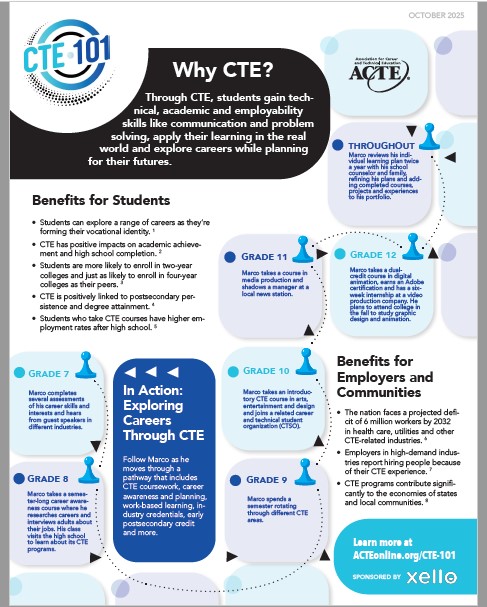
Why CTE?
Through CTE, students gain technical, academic and employability skills like communication and problem solving, apply their learning in the real world and explore careers while planning for their futures.
Benefits for Students
- Students can explore a range of careers as they’re forming their vocational identity (Connected Learning Alliance).
- CTE has positive impacts on academic achievement and high school completion (CTE Research Network).
- Students are more likely to enroll in two-year colleges and just as likely to enroll in four-year colleges as their peers (CTE Research Network).
- CTE is positively linked to postsecondary persistence and degree attainment (Urban Institute).
- Students who take CTE courses have higher employment rates after high school (Urban Institute).
Benefits for Employers and Communities
- The nation faces a projected deficit of 6 million workers by 2032 in health care, utilities and other CTE-related industries (Lightcast).
- Employers in high-demand industries report hiring people because of their CTE experience (Advance CTE).
- CTE programs contribute significantly to the economies of states and local communities (ACTE).
In Action: Exploring Careers Through CTE
Follow Marco as he moves through a pathway that includes CTE coursework, career awareness and planning, work-based learning, industry credentials, early postsecondary credit and more —
- Grade 7: Marco completes several assessments of his career skills and interests and hears from guest speakers in different industries.
- Grade 8: Marco takes a semester-long career awareness course where he researches careers and interviews adults about their jobs. His class visits the high school to learn about its CTE programs.
- Grade 9: Marco spends a semester rotating through different CTE areas.
- Grade 10: Marco takes an introductory CTE course in arts, entertainment and design and joins a related career and technical student organization (CTSO).
- Grade 11: Marco takes a course in media production and shadows a manager at a local news station.
- Grade 12: Marco takes a dual-credit course in digital animation, earns an Adobe certification and has a six-week internship at a video production company. He plans to attend college in the fall to study graphic design and animation.
- Throughout: Marco reviews his individual learning plan twice a year with his school counselor and family, refining his plans and adding completed courses, projects and experiences to his portfolio.





